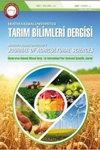Cadmium Toxicity and its Effects on Growth and Metal Nutrient Ion Accumulation in Solanaceae Plants
IF 1.1
4区 农林科学
Tarim Bilimleri Dergisi-journal of Agricultural Sciences
Pub Date : 2016-12-12
DOI:10.1501/TARIMBIL_0000001416
引用次数: 17
Abstract
The effect of cadmium (Cd) toxicity was studied in four Solanaceae plants (tomato, Solanum lycopersicum L.; pepper, Capsicum annuum L.; eggplant, Solanum melongena L., and goldenberry, Physalis peruviana L.) grown in greenhouse under natural light conditions. The soil was treated with five levels of Cd (0, 2.5, 5, 10 and 20 mg kg-1). Except for the tomato, the shoot and root dry biomass decreased with increasing Cd. Plant growth, bioaccumulation and translocation of Cd and accumulation of metal nutrient ions [potassium (K), calcium (Ca), magnesium (Mg), sodium (Na), iron (Fe), manganese (Mn), copper (Cu) and zinc (Zn)] were investigated. On the basis of the percent reductions in the shoot dry biomass, the tomato was determined to be Cd-tolerant, and the other plants Cd-sensitive. The shoot and root Cd contents, uptakes, and total accumulation rate (TAR) were increased with increasing rate of Cd applied, except for the shoot Cd content and root uptake of the goldenberry. The bioconcentration factor (BCF) and the translocation factor (TF) of Cd diminished at all plants, with the exception of the TF for tomato. With respect to Cd translocation, plant species showed a ranking as follows: goldenberry镉毒性及其对茄科植物生长和金属营养离子积累的影响
研究了4种茄科植物(番茄、番茄茄;辣椒,辣椒;在温室自然光条件下栽培的茄子(Solanum melongena L.)和金莓(Physalis peruviana L.)。采用0、2.5、5、10、20 mg kg-1 5个水平的Cd处理土壤。除番茄外,茎部和根系干生物量均随Cd的增加而减少。研究了植株生长、Cd的生物积累和转运以及金属营养离子[钾(K)、钙(Ca)、镁(Mg)、钠(Na)、铁(Fe)、锰(Mn)、铜(Cu)和锌(Zn)]的积累。根据茎部干生物量减少的百分比,确定番茄耐cd,其他植物对cd敏感。除金梅茎部Cd含量和根系Cd吸收量显著增加外,其他品种的茎部和根系Cd含量、Cd吸收量和总积累速率均随Cd施用量的增加而增加。除番茄的生物富集因子(BCF)和转运因子(TF)外,其他植株Cd的生物富集因子(BCF)和转运因子(TF)均降低。在Cd转运方面,植物种类排列顺序为:金莓<辣椒<茄子<番茄。施镉增加了金梅嫩芽中所有金属营养离子的积累。除锌和铜外,二价金属营养离子在辣椒和茄子中积累量增加,而钾作为一价金属营养离子在辣椒中积累量减少。
本文章由计算机程序翻译,如有差异,请以英文原文为准。
求助全文
约1分钟内获得全文
求助全文
来源期刊
CiteScore
1.40
自引率
0.00%
发文量
26
期刊介绍:
Journal of Agricultural Sciences (JAS) is an international, double-blind peer-reviewed, open-access journal, published by the Faculty of Agriculture, Ankara University. The journal invites original research papers containing new insight into any aspect of Agricultural Sciences that are not published or not being considered for publication elsewhere. Preliminary, confirmatory or inconclusive research, review articles, case and local studies and works presenting taxonomy will not be published.
联系我们:info@booksci.cn
Book学术提供免费学术资源搜索服务,方便国内外学者检索中英文文献。致力于提供最便捷和优质的服务体验。
Copyright © 2023 布克学术 All rights reserved.
京ICP备2023020795号-1
 京公网安备 11010802042870号
京公网安备 11010802042870号
京ICP备2023020795号-1

Book学术文献互助群
群 号:604180095


 求助内容:
求助内容: 应助结果提醒方式:
应助结果提醒方式:
